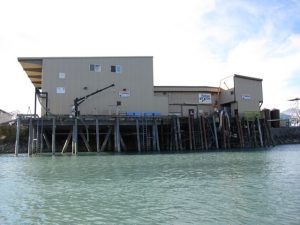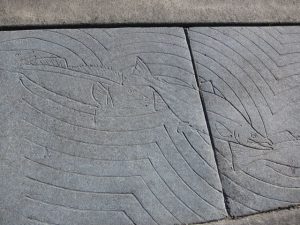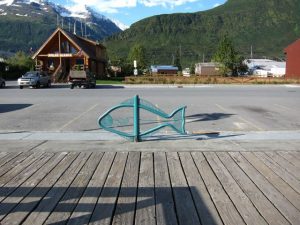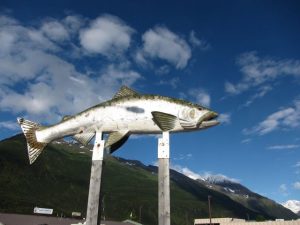
“Copper River Salmon”
by Catherine Schmitt
I recently spent a week on vacation touring the state of Alaska. My tour featured two days in Valdez, a fishing port which is also, as the terminus of the Trans-Alaska Pipeline, an oil port. The port was the destination for the tanker Exxon Valdez, which ran aground on Bligh Reef and spilled more than 11 million gallons of oil into wildlife-rich Prince William Sound in 1989. The oil never made its way into Valdez Harbor.
This is fortunate for the town of Valdez, which welcomes tourists with fishing derbies, glacier tours, and the small but impressive Whitney Museum. Fish are everywhere here: etched in the sidewalks, forged into bike racks, and hoisted above town. Valdez also is home to a processing plant for Copper River Salmon.
I spoke to Beth Poole, Executive Director of Copper River Marketing, at the Boston Seafood Show in 2009, for a story on the history of seafood marketing for Maine Food & Lifestyle magazine. According to Poole, “Copper River Salmon” was one of several brands that emerged out of fishermen’s concerns about processors controlling the market. State legislation in 2004 enabled them to assess a one-percent regional seafood development tax, in this case on the regional drift gillnet fleet to fund the Copper River Marketing Association in 2005.

Today, Copper River Salmon has successfully branded itself as distinct from the same species of salmon found in other rivers throughout Alaska (something about fat needed to travel the river’s 300-mile length). See for example, mentions in the Minneapolis Star-Tribune and Sacramento Bee, among others.
In 2011, Alaska led all states in volume of fish landings at 5.4 billion pounds (dominated by pollock and salmon) and value of landings with $1.9 billion (dominated by crab and salmon). Yet only a small percentage of annual landings makes it onto American dinner plates, as we import 86 percent of our seafood.
While there seems to be a lot of talk about seafood marketing these days, we can’t market what we don’t have. According to Erik Chapman of New Hampshire Sea Grant, “We need to transition to food systems that can support lower volume, higher value species, more and different kinds of fish.”
The rarity of local seafood (when compared to the volume of imports nationally) is enough to make local seafood taste good, but if that local seafood happens to be Copper River salmon, cooked over a campfire on a narrow shelf between the Chugach Mountains and the Pacific Ocean, well, it might taste even better.



